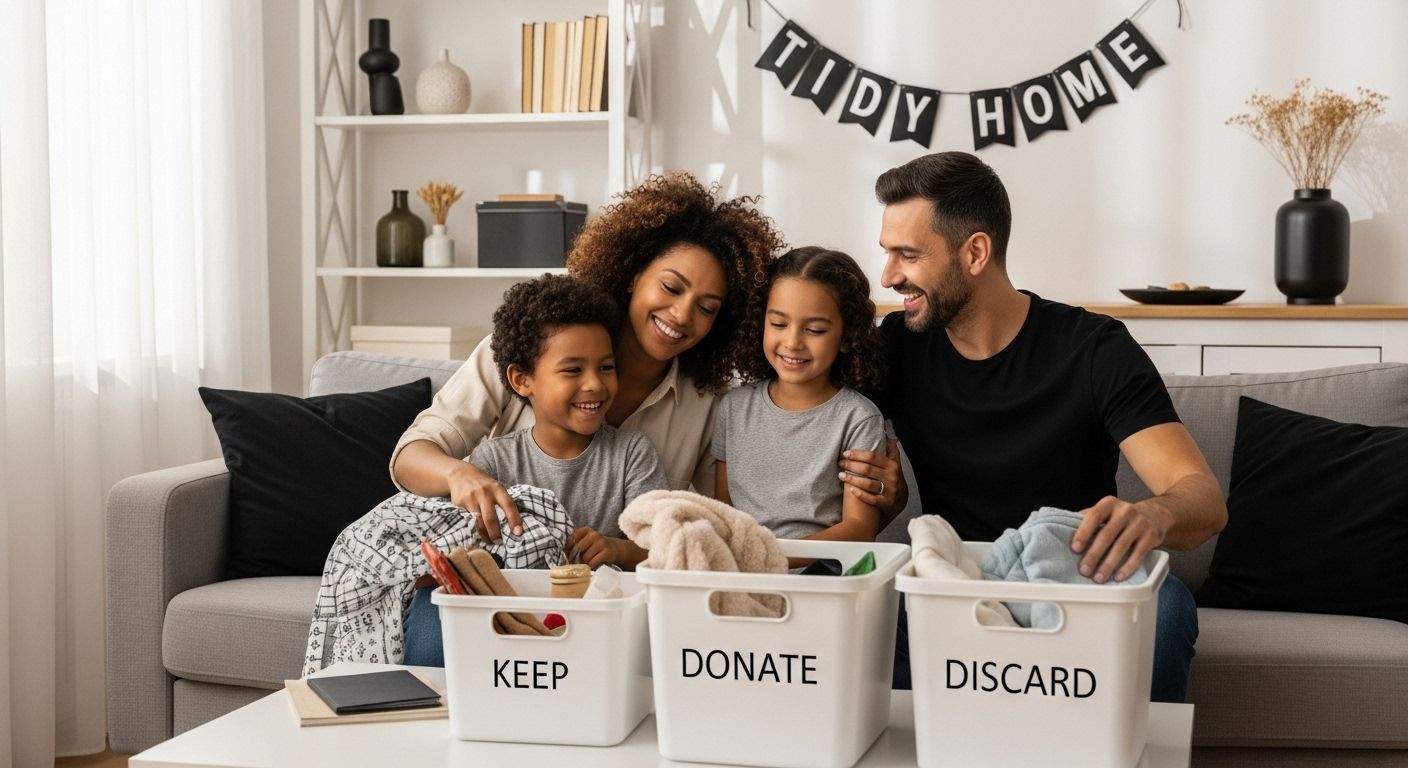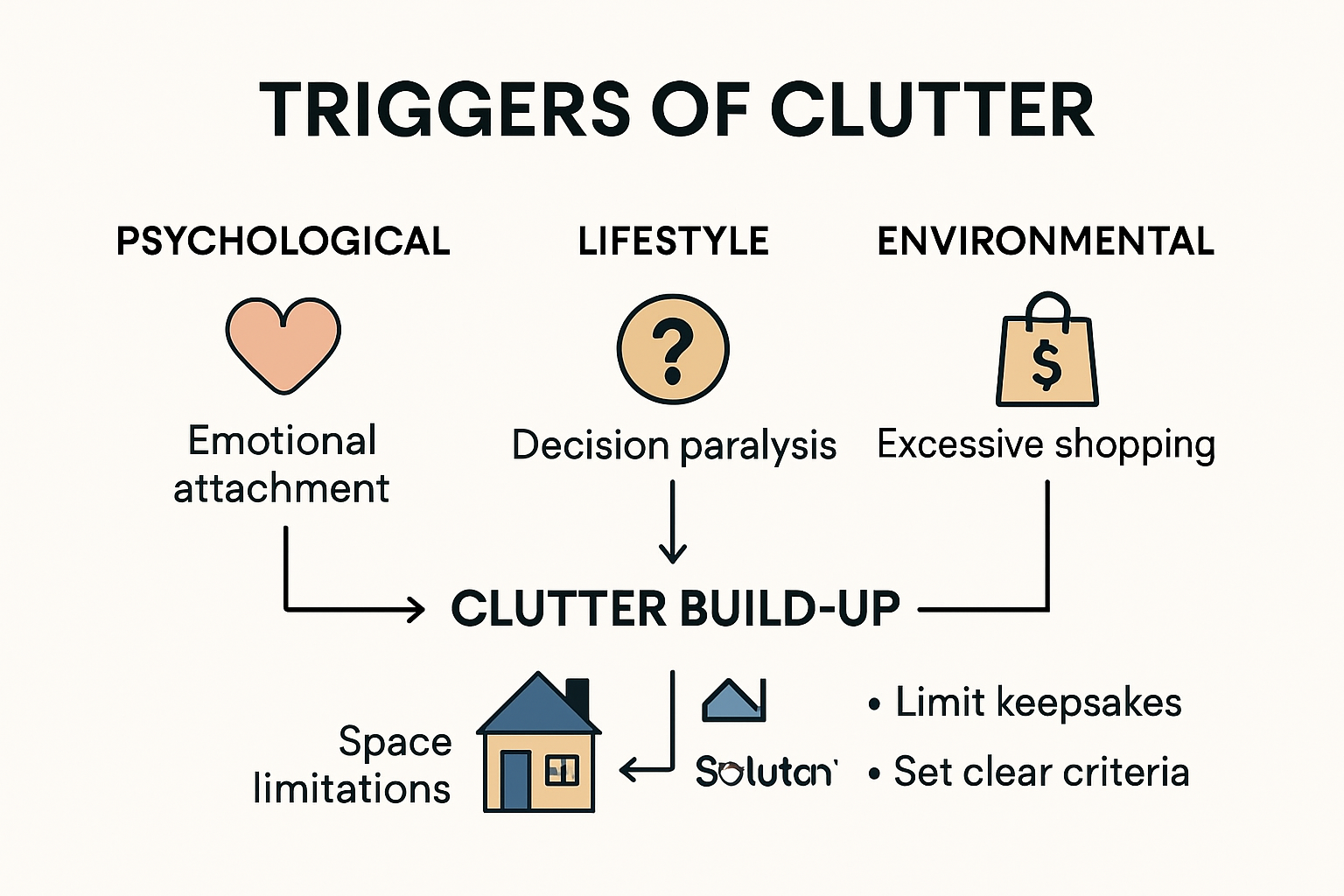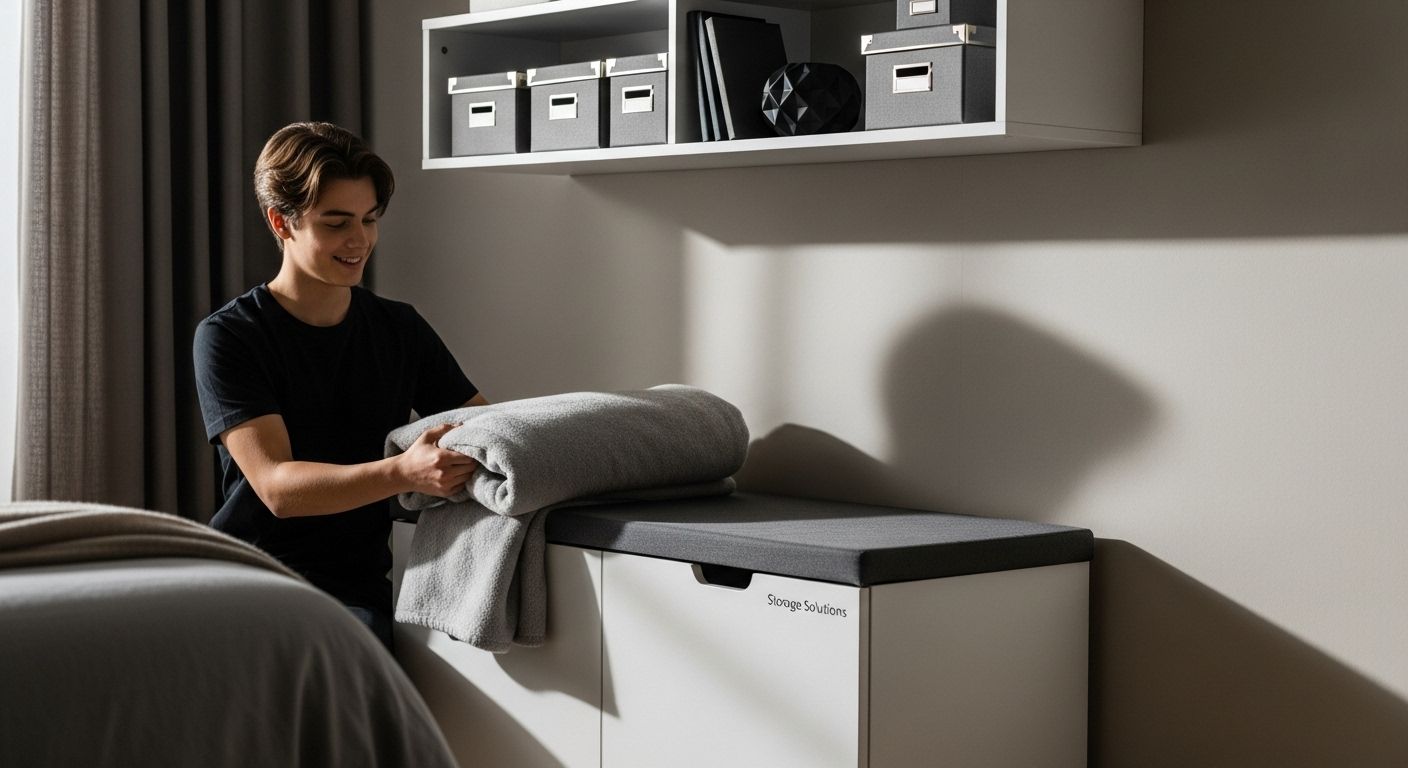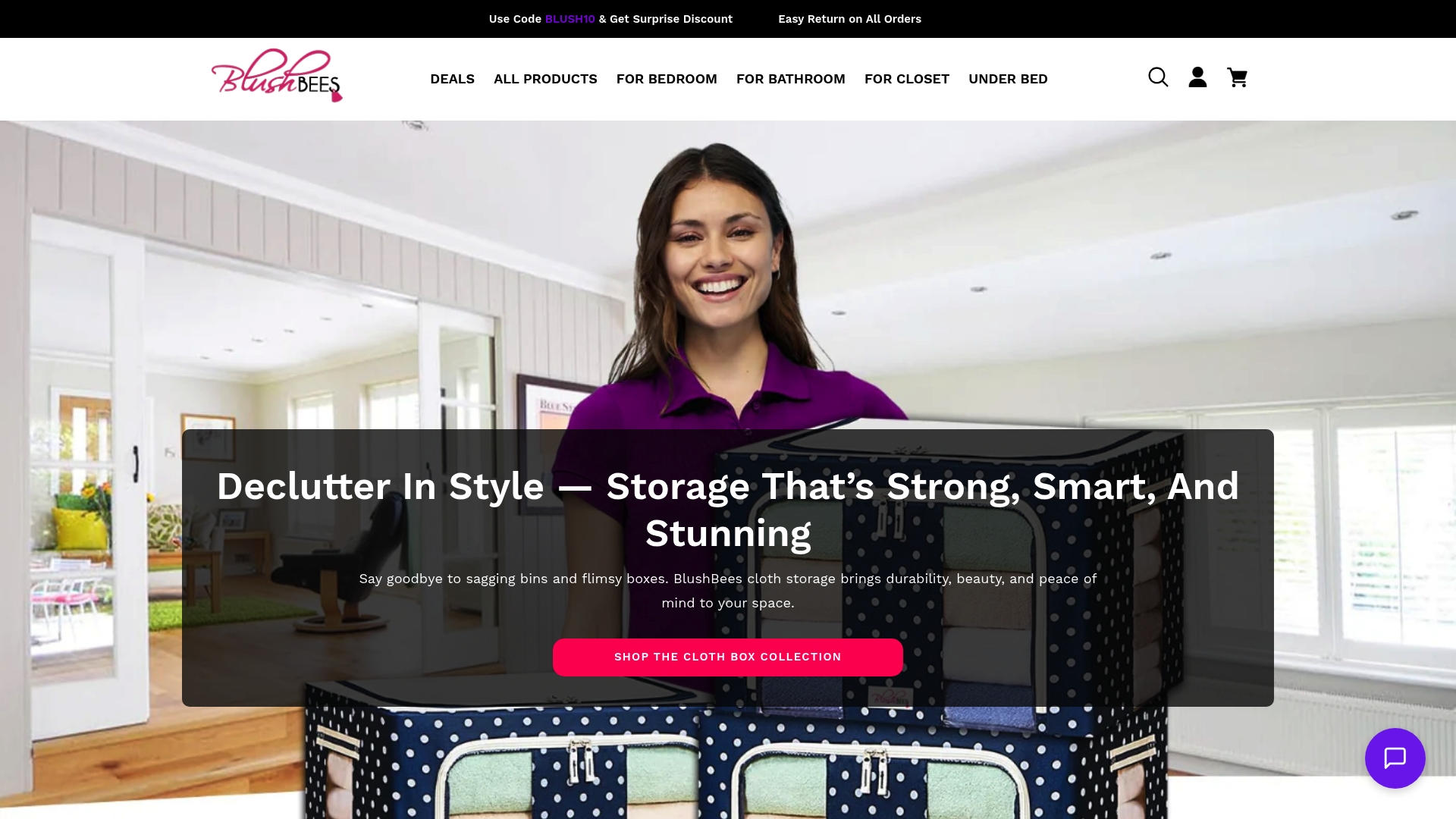

Clutter silently creeps into our homes, turning once calm spaces into chaotic piles of stuff that raise stress levels and leave us feeling weighed down. Now, you might be surprised to hear that just 15 minutes of daily decluttering has been shown to meaningfully improve mental well-being according to ColumbiaDoctors. Yet the real secret is that organizing your home is less about how hard you work and more about understanding the hidden reasons you hold onto things in the first place. Get ready to rethink everything you know about tidying up.
Table of Contents
- Understanding Why Clutter Happens
- Proven Decluttering Methods That Work
- Smart And Stylish Storage Solutions
- Maintaining A Clutter-Free Home Daily
Quick Summary
| Takeaway | Explanation |
|---|---|
| Understand clutter’s causes | Recognize psychological, lifestyle, and environmental factors leading to clutter accumulation. |
| Implement the Sort and Purge Strategy | Categorize items into keep, donate, sell, and discard for effective decision-making. |
| Adopt time-bound decluttering techniques | Use the 15-minute rule for daily decluttering sessions to maintain manageable progress. |
| Utilize vertical space for storage | Maximize wall areas with shelves and racks to free up floor space and create interest. |
| Establish daily cleaning rituals | Create two-minute daily tasks to prevent clutter from building up and maintain organization. |
Understanding Why Clutter Happens
Clutter doesn’t just appear overnight. It’s a complex phenomenon rooted in psychological, behavioral, and environmental factors that gradually transform our living spaces from organized to overwhelmed. Understanding the underlying reasons why clutter accumulates is crucial to developing effective strategies for maintaining a tidy home.

Psychological Triggers of Clutter
People often struggle with clutter due to deep-seated psychological patterns. Research from the National Institutes of Health reveals that individuals experiencing clutter frequently face challenges with decision-making and emotional attachment to possessions. Decisional procrastination plays a significant role in this process. When confronted with choices about keeping or discarding items, many people experience decision paralysis.
Cognitive factors contribute substantially to clutter accumulation. A comprehensive study published in psychological research demonstrated that hesitation and avoidance behaviors are primary reasons people struggle to organize their spaces. Some individuals develop emotional connections to objects, viewing them as memory repositories or potential future resources, which makes discarding items emotionally challenging.
Lifestyle and Consumption Patterns
Modern consumer culture significantly contributes to clutter. The ease of online shopping, bulk purchases, and constant marketing bombardment encourage accumulating items beyond our immediate needs. University extension research highlights that excessive spending and frequent gift-receiving are major contributors to household clutter.
Busy lifestyles compound the problem. With limited time and energy, people often choose temporary solutions like storing items instead of making decisive organizational choices. This gradual accumulation creates a cycle where managing possessions becomes increasingly overwhelming.
Environmental and Systemic Factors
Physical space limitations and inadequate storage solutions further exacerbate clutter issues. When homes lack proper organizational systems, items naturally accumulate in random spaces. Mental health conditions can also influence clutter formation, with some individuals experiencing more significant challenges in maintaining organized environments.
Recognizing these underlying reasons transforms clutter management from a cleaning task to a holistic personal development journey. By understanding the psychological and practical roots of disorganization, individuals can develop more compassionate and effective strategies for creating and maintaining tidy living spaces. Check out our guide on making tidying enjoyable to learn how to make the process more engaging and sustainable.
Below is a comparison table summarizing common causes of clutter, their descriptions, and example solutions as discussed in the article. This helps readers quickly understand the different root causes and how to address them.
| Cause of Clutter | Description | Example Solution |
|---|---|---|
| Psychological Triggers | Struggles with decision-making, emotional attachment | Recognize emotional ties, practice letting go |
| Lifestyle & Consumption Patterns | Consumerism, busy schedules, excess purchasing | Be mindful with purchases, start small |
| Environmental/Systemic Factors | Limited space, poor storage, mental health challenges | Improve storage, seek appropriate support |
Remember, clutter reduction isn’t about achieving perfection but creating functional, peaceful living environments that support your lifestyle and well-being.
Proven Decluttering Methods That Work
Transforming a cluttered space into an organized sanctuary requires strategic approaches and practical techniques. Effective decluttering is not about perfection but creating functional living environments that reduce stress and improve daily productivity.
The Sort and Purge Strategy
Research from the University of Georgia Cooperative Extension recommends a systematic approach to decluttering that involves sorting items into clear categories. This method allows individuals to make decisive choices about their possessions. Begin by creating four primary categories: keep, donate, sell, and discard. Immediate sorting prevents items from returning to their original cluttered spaces.
The key is to be ruthless yet thoughtful. Ask critical questions about each item: When was the last time you used it? Does it serve a current purpose? Does it bring genuine joy or value to your life? Mississippi State University Extension Service suggests setting reasonable goals and starting with small, manageable areas to build momentum and confidence in the decluttering process.
Here’s a step-by-step process table summarizing the Sort and Purge Strategy, outlining the primary actions involved in this effective decluttering method.
| Step | Action | Purpose |
|---|---|---|
| 1. Select Area | Choose a small, manageable space | Prevent overwhelm and build momentum |
| 2. Sort Items | Separate belongings into four categories | Clarifies what to keep or remove |
| 3. Purge | Donate, sell, or discard as sorted | Removes unneeded items from the home |
| 4. Organize | Return kept items thoughtfully | Maintains order and avoids re-cluttering |
Time-Bound Decluttering Techniques
Effective decluttering requires structure and time management. Set specific time limits for organizing each space to prevent overwhelming yourself. The 15-minute rule works remarkably well: commit to decluttering for just 15 minutes daily. This approach makes the task less daunting and more sustainable. ColumbiaDoctors emphasizes that consistent, small efforts can significantly reduce stress and improve mental well-being.
Consider implementing a one-in-one-out rule. For every new item you bring into your home, remove one existing item. This prevents future clutter accumulation and encourages more mindful purchasing decisions. Check out our expert tips for comprehensive home organization to refine your decluttering strategy.
Digital and Physical Decluttering
Decluttering extends beyond physical spaces to digital environments. Organize digital files, clean email inboxes, and delete unnecessary digital documents. Apply the same sorting principles to your digital world as you would to physical spaces. Backup important files, delete duplicates, and create a systematic folder structure.
Remember that decluttering is an ongoing process. Maintain your organized spaces by developing consistent habits. Regular maintenance prevents clutter from rebuilding and helps you create a more peaceful, functional living environment. The goal is not immaculate perfection but a sustainable system that works for your lifestyle and reduces daily stress.
Smart and Stylish Storage Solutions
Effective storage solutions are more than just functional organizational tools. They represent a strategic approach to transforming living spaces, combining aesthetics with practicality while maximizing available room. Modern storage design focuses on creating systems that are both visually appealing and highly efficient.
Vertical Space Optimization
Research from the Rocky Mountain College of Art + Design highlights the importance of utilizing vertical spaces as a game-changing storage strategy. Floating shelves, wall-mounted racks, and tall bookcases transform empty wall areas into dynamic storage zones. These solutions not only free up floor space but also create visual interest in rooms.
Vertical storage allows homeowners to think beyond traditional horizontal storage methods. Install shelving units that reach toward the ceiling, use over-door organizers, and implement hanging storage systems in closets and utility areas. Discover expert tips for small space storage solutions to maximize every inch of your living environment.
Multifunctional Furniture and Hidden Storage
Rice University’s research emphasizes intelligent design in creating multifunctional furniture pieces. Ottoman seats with internal compartments, beds with integrated drawers, and coffee tables featuring hidden storage compartments represent innovative approaches to reducing visible clutter.
The key is selecting pieces that serve dual purposes. A bench with built-in storage can function as seating and a place to store extra linens or seasonal clothing. Modular furniture systems allow customization, enabling homeowners to adapt storage solutions to their specific needs. Explore creative under-bed storage techniques to unlock additional storage potential in bedrooms.
Innovative Material and Design Approaches
A comprehensive study titled ‘FabHacks’ explores transforming everyday objects into functional storage fixtures. Clear acrylic organizers, magnetic wall systems, and stackable transparent containers represent modern solutions that maintain visual transparency while keeping items accessible.
Consider materials and designs that complement your existing decor. Woven baskets, metal wire frames, and wooden crates can add texture and character while providing practical storage. The goal is creating a cohesive look that integrates storage seamlessly into your living space.

Remember that effective storage is an ongoing process. Regularly reassess your storage systems, adapt to changing needs, and prioritize solutions that bring both organization and aesthetic pleasure to your home.
Maintaining a Clutter-Free Home Daily
A clutter-free home is not a destination but a continuous journey of mindful daily practices. Transforming your living space requires consistent effort and strategic habits that prevent disorder from accumulating. The key is developing a proactive approach that integrates organization into your everyday routine.
Daily Cleaning and Sorting Rituals
Mississippi State University Extension Service emphasizes that creating daily habits is crucial for maintaining an organized home. Establishing simple two-minute routines can significantly prevent clutter buildup. These might include sorting mail immediately upon arrival, cleaning kitchen surfaces after meals, and putting items back in their designated spaces.
Quick daily tasks can transform your home’s organization. Make your bed each morning, spend five minutes clearing countertops, and handle incoming papers immediately. One-touch rule works effectively: when you touch an item, deal with it completely rather than moving it from one place to another. Discover expert strategies for keeping your home consistently tidy to streamline your approach.
Kitchen and High-Traffic Area Management
University of Minnesota Extension recommends specific daily kitchen maintenance practices. After each meal, wash dishes immediately, wipe down counters, sweep floors, and clean the stovetop. High-traffic areas like entryways, living rooms, and kitchen require special attention. Create designated drop zones for keys, mail, and shoes to prevent these items from spreading throughout your home.
Consider implementing a nightly 10-minute reset routine. Spend this time returning items to their proper places, clearing surfaces, and preparing for the next day. This small investment prevents overwhelming cleanup sessions and maintains a sense of order. Learn how to make tidying enjoyable and transform cleaning from a chore to an enjoyable activity.
Environmental Maintenance and Prevention
New York State Department of Health highlights the importance of maintaining a dry, clean environment. Address potential moisture issues promptly, use exhaust fans in bathrooms and kitchens, and regularly inspect areas prone to clutter and potential damage.
Develop a mindset of continuous improvement. Regular maintenance prevents overwhelming accumulation. Set realistic expectations and understand that perfection is not the goal. The objective is creating a functional, comfortable living space that supports your lifestyle. Small, consistent actions compound over time, transforming your home into an organized, peaceful environment.
Remember, maintaining a clutter-free home is about creating systems that work for you, not adhering to impossible standards. Consistency, not perfection, is the true path to an organized living space.
Frequently Asked Questions
How can I effectively start decluttering my home?
Begin by using the Sort and Purge Strategy. Create four categories: keep, donate, sell, and discard. Focus on small areas to build momentum and make decisions about items based on their usefulness and emotional value.
What are some daily habits to maintain a clutter-free environment?
Establish quick daily routines such as making your bed, cleaning up kitchen surfaces after meals, and sorting mail immediately upon arrival. Implementing the one-touch rule can also help manage clutter effectively.
How long should I dedicate to decluttering each day?
Aim for just 15 minutes of decluttering each day. This time-bound approach helps make the task manageable and prevents overwhelm, allowing for consistent progress without feeling daunting.
What are some smart storage solutions for small spaces?
Utilize vertical space with shelves and wall-mounted racks, invest in multifunctional furniture with hidden storage, and use clear containers to keep items organized. These solutions maximize space while maintaining aesthetic appeal.
Transform Clutter Into Calm With Smart Storage Solutions
Is your bedroom overflowing with clothes and everyday essentials despite your best efforts to declutter? You are not alone. The article explains how emotional attachments, busy routines, and lack of storage can keep even the most organized people feeling stuck in the clutter cycle. When you want a peaceful, organized retreat, but piles of possessions keep reappearing, it’s time to rethink your approach with solutions made to match your space and your style.

Explore our wide range of Bedroom Storage options that turn every inch of your space into a calm oasis. At BLUSHBEES USA, you will discover storage boxes, baskets, and compartment organizers uniquely designed to support the Sort and Purge Strategy discussed in the article. Take control of your home now and let our stylish storage products help you keep clutter away for good. Shop today and experience how small changes can lead to lasting peace and order.
Recommended
- Where to Start When Your Whole House is a Mess: Expert Tips – BLUSHBEES USA
- 10 Home Organization Tips for a More Tidy and Efficient Living Space – BLUSHBEES USA
- How to Declutter Before Moving: Tips for a Fresh Start in 2025 – BLUSHBEES USA
- Having Fun While Staying Tidy. Is It Possible? – BLUSHBEES USA



